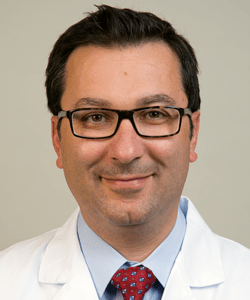According to current estimates, prostate cancer is the most frequently diagnosed cancer in men after skin cancer. About 220,800 new cases of prostate cancer are diagnosed each year in the United States, and more than 27,500 of these patients die from the disease. Studies indicate that more and more men diagnosed with low-risk prostate cancer are opting for active surveillance rather than aggressive treatment to avoid the potentially debilitating side effects associated with surgery and radiation, such as erectile and urinary dysfunction. Active surveillance involves routine PSA testing, regular office visits for physical examinations, and at least one additional prostate biopsy within a 2-year period.
An Important Comparison
“There has been significant interest in the utilization of active surveillance for men with prostate cancer,” says Karim Chamie, MD. Despite this goal, few studies have examined the quality of surveillance for patients with prostate cancer. To address this research gap, Dr. Chamie and colleagues had a study published in Cancer that explored the intensity of surveillance among patients diagnosed with localized prostate cancer who opted for watchful waiting/active surveillance and compared it with those who received active treatment.
The authors examined records of 37,687 men aged 65 and older who were diagnosed with prostate cancer between 2004 and 2007 and followed them through 2009. “Less than 5% of men diagnosed with prostate cancer who did not undergo aggressive treatment were being monitored appropriately,” says Dr. Chamie. When compared with patients who were receiving active treatment, those undergoing watchful waiting/active surveillance were less likely to receive PSA testing and to attend office visits within the 2 years after diagnosis.
Significant Ramifications
“Our data demonstrate the importance of physician and patient concordance to closely monitor prostate cancer,” Dr. Chamie says. “This is a call to action to ensure agreement before decisions are made to pursue active surveillance as a management option.” The study also found that men who underwent aggressive treatment for prostate cancer were more likely to receive routine laboratory testing and visit their physician than those not receiving aggressive treatment. “Simply put, patients who were likely cured with aggressive treatment were followed more closely than those whose cancers were left untreated,” adds Dr. Chamie.
Dr. Chamie says that patients who opt for active surveillance are in danger of their cancer progressing or metastasizing without their knowledge. Experts are advocating for active surveillance for men with low-risk disease, but it is critical that physicians and patients are both committed to closely monitoring the cancer with repeat biopsy, PSA testing, and physical exams. These patients may harbor more aggressive tumors.
More research is needed to qualitatively describe the contributing factors that drive decision-making recommendations and to improve surveillance measures for men with prostate cancer. The study also demonstrated that there was a small but statistically significant increase in follow-up intensity with time. As more time passed, patients were more likely to receive the recommended tests for active surveillance. Future analyses should determine if improved compliance leads to plateaus or if it accelerates over a longer period of time.



 PWeekly
PWeekly